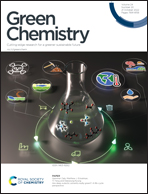Novel tributyl phosphate-based hydrophobic deep eutectic solvent: application in simultaneous liquid–liquid microextraction of parabens and their metabolite in surface water samples†
Abstract
A novel deep eutectic solvent (DES) with tributyl phosphate (TBP) as hydrogen bond acceptor and D,L-menthol (M) as hydrogen bond donor (HBD) was synthesized for the first time. M, a natural perfume, was selected as the HBD of the promising DES to tailor the extraction capacity and greenify the extraction solvent. The designed TBP–M (molar ratio 1 : 2)-based DES was applied in the simultaneous liquid–liquid microextraction (LLME) of a group of parabens (PBs) and their metabolite (p-hydroxybenzoic acid, PHBA) with wide polarity range in surface water samples. The developed LLME was combined with high-performance liquid chromatography and showed low detection limits (0.5–0.9 μg L−1) and good linearity (R2 ≥ 0.9983), precisions (RSDs ≤ 7.6%) and recoveries (86.0% to 110%) under the optimum conditions. The presented procedure has the features of simplicity, inexpensiveness, effectiveness and reliability, and the novel DES has great potential in the highly effective and simultaneous extraction for compounds with different polarities such as PBs and PHBA in complex real water samples.



 Please wait while we load your content...
Please wait while we load your content...